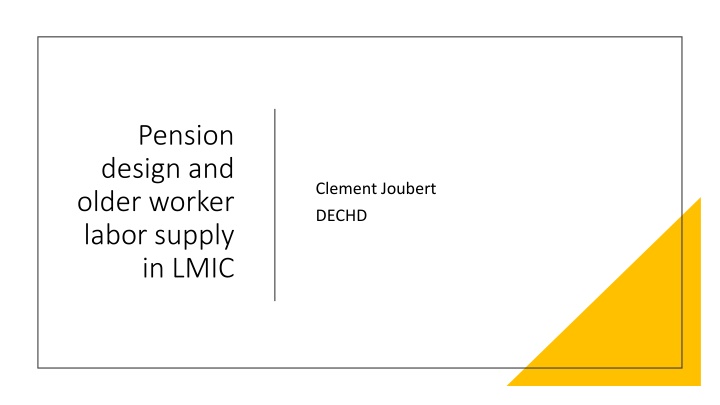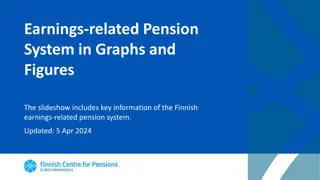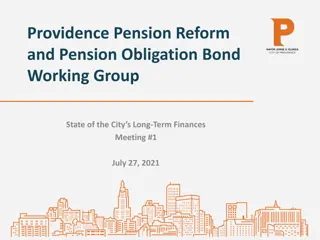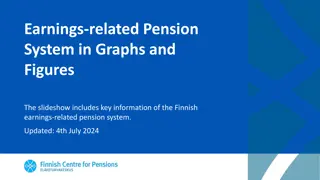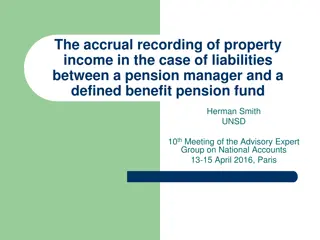Challenges in Pension Design for Older Worker Labor Supply
Low pension coverage and contribution rates, especially among low earners and women, pose challenges for pension systems globally. The need to cover infrequent contributors and retain skilled workers in the labor force longer becomes crucial in the face of aging populations and rising dependency ratios. Solutions such as survivorship pensions and non-contributory benefits are discussed to address these challenges.
Download Presentation

Please find below an Image/Link to download the presentation.
The content on the website is provided AS IS for your information and personal use only. It may not be sold, licensed, or shared on other websites without obtaining consent from the author.If you encounter any issues during the download, it is possible that the publisher has removed the file from their server.
You are allowed to download the files provided on this website for personal or commercial use, subject to the condition that they are used lawfully. All files are the property of their respective owners.
The content on the website is provided AS IS for your information and personal use only. It may not be sold, licensed, or shared on other websites without obtaining consent from the author.
E N D
Presentation Transcript
Pension design and older worker labor supply in LMIC Clement Joubert DECHD
Low pension coverage across people and over lifetimes Even fewer consistent contributors, particularly among women 2/3 workers worldwide do not contribute to a formal pension scheme Source: EPS and Chilean pension system data Source: Pallares-Miralles et al. (2012) using World Bank Pension database
Low earners have lower contribution densities Continuous formal employment histories tend to be associated with high earners Low earners are more likely to contribute infrequently or not at all, leading to low replacement rates E.g.: Fraction with over 80% contribution densities in Peru s SPP Top income quintile: Bottom income quintile: Source: Freudenberg & Toscani 2019
High LFP after age 65 Male LFP by self-reported health Male LFP by education level 0.9 0.9 0.8 0.8 0.7 0.7 0.6 Fraction working Fraction working 0.6 0.5 0.5 0.4 0.4 0.3 0.3 0.2 0.2 0.1 0.1 0 0 55 60 65 70 75 80 55 60 65 70 75 80 Age Age Basica Media Universitaria Mala Regular Buena
Pension design challenge 1: Covering infrequent contributors In HI countries: Infrequent contributors tend to be married women Typically married to a consistent contributor Main instrument: survivorship pensions In LMI countries: Infrequent contributors tend to be lower earning men and women Many households lack a consistent contributor, so survivorship pensions are not sufficient High rates labor force participation after age 65 => lower health levels, low productivity and high disutility of labor Main instrument: broad non-contributory benefits
Pension design challenge 2: Keeping (skilled) workers in the formal labor force longer Fast aging in LMIC implies rising dependency ratios, lower GDP per capita growth and increasing pension deficits Need to keep skilled workers in the formal labor force longer Many generous/unsustainable formal pension systems small coverage often limited to public and large formal company workers covers highly educated workers Disincentives for formal force participation (similar to HIC pension systems) High replacement rates Low retirement ages Actuarially unfair early retirement provisions Legal hindrance to delaying retirement past legal retirement age or combining pension receipt with labor supply
Integrating contributory and non-contributory pensions: Chile s 2008 reform Main parameters defining an integrated minimum pension: Level of basic pension Claw-back rate/Implicit tax rate Years of contribution requirement Means test Wealth effect: Larger government transfers lower the marginal utility of wealth which reduces lifetime labor force participation Substitution effect: Claw-back lowers pension accrual rates affect labor force participation and formality by altering the effective wage in the formal sector. Impacts analyzed in Joubert & Todd (2023)
Data: Linking administrative records and longitudinal survey data Pension research requires long panels! => administrative pension records Full formal labor histories, Earnings can be backed out from contributions (up to the taxable limit) Usually accurate Limited socio demographics No information on informal jobs Chile: linked longitudinal survey (Encuesta de Proteccion Social) Admin pension records as sampling frame, representative of all affiliates Completed sample with non-contributors to obtain representative sample Retrospective self-reported employment histories can be checked against admin records Additional information on household wealth, health, family history, pension and financial knowledge etc.
Policy analysis using an estimated structural model 1. Develop a model Develop a dynamic model of households labor supply and saving decisions Rich observed and unobserved heterogeneity to capture the formal/informal margin Estimate parameters Estimate the model s parameters using panel data on Chilean households Identification from panel data (Taber & Vejlin (2020)) Validate model prediction with quasi-experimental variation or literature Simulate policies (Micro)-simulate labor supply, saving decisions, pension benefits, government costs under different pension designs to isolate their effect 2. 3. 4.
Impacts of Chiles 2008 reform on labor supply (Joubert & Todd 2023) New design appears to improve incentives for work before age 60 lower implicit tax, less stringent means-test Negative wealth effect dominates after age 60 Moderate impact magnitudes (-/+ 5 percentage points), consistent with non-structural studies: triple diff (Behrman et al., 2011), DinD with matching (Encina, 2013), reduced-form modelling of pension incentives (Attanasio et al., 2011, Becerra, 2019)
Impacts of Chiles 2008 reform on labor supply (Joubert & Todd 2023) Negative effect concentrated on married men and women and higher schooling levels: Transfers increase most for non- poor households with non-working women Important to consider household structures in pension design!
Additional challenge: Pension knowledge levels are low Fewer than 1 in 8 Chilean workers knew the eligibility requirements for a minimum pension in 2008
Imperfect take- up of pension benefits (Joubert & Troncoso 2023) Combine administrative records and linked survey to measure and analyze the take up of non-contributory pension benefits Preliminary results show that less than 60% of those eligible for the non-contributory minimum pension in Chile actually receive it Implications for: Incentives for labor supply Old age poverty Inequality/Effective targeting Political support for the system
